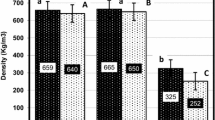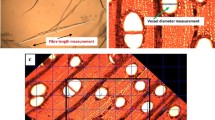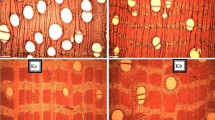Abstract
As wood resources deplete, branchwood is being promoted to supplement stemwood in Ghana, but its natural durability, which indicates its service life and can influence its acceptance and use is scarcely studied. This study compares the natural durability and some anatomical properties of branchwood and stemwood of Entandrophragma cylindricum (sapele) and Khaya ivorensis (mahogany) using Ceiba pentandra stemwood as control. Natural durability test followed field test method according to European Standard EN 252 1989 in combination with percentage weight losses while the anatomical investigations followed IAWA Committee 1989 recommendations. For each species, two branch logs were cut from each of two sampled trees from two natural forests in Ghana. Stemwood was also obtained from the same forest reserves as the branches. All sample groups were tested at air-dried moisture content of 14 ± 2 % as specified in the standard. Branchwood of both species were denser than their stemwood, but in addition to mahogany stemwood they were rated “non-durable”, while sapele stemwood was rated moderately durable. Thus at 5 % significance level, natural durability of mahogany branchwood appeared comparable to that of its stemwood whereas sapele branchwood was significantly less durable than its stemwood but more durable than Ceiba stemwood. Branchwood and stemwood vessels diameter and proportion also were significantly different (p < 0.1). Expectedly, density correlated positively with natural durability, but the correlation among anatomical properties, natural durability and density were stronger in stemwood than in branchwood. In conclusion, stem and branchwood of mahogany are both non-durable but sapele stemwood appears better than its branchwood for ground applications. Anatomical properties of stemwood influenced natural durability more than those of branchwood. For better acceptance of branchwood of the species for wood products manufacturing, further research would be necessary for additional data on their toxic extractive levels, mechanical properties and durability at different sites or/and using other drying methods.



Similar content being viewed by others
References
Acquah ET, Whyte C (1998) The potential for Ghana’s wood/wood products in the US market office of sustainable development, USAID Africa Bureau, pp 8–133
Agyarko T (2001) FAO corporate document repository FOSA Forestry Outlook Study for Africa, Country Report—Ghana, Ministry of Land and Forestry. 2nd draft FOSA/WP/12 pp 1–49
Amoah M, Appiah-Yeboahand J, Okai R (2012) Characterization of physical and mechanical properties of branch stem and root wood of iroko and emire tropical trees. Res J Appl Sci Eng Technol 4(12):1754–1760
Antwi-Boasiako C, Pitman AJ (2009) Influence of density on the durability of three Ghanaian timber. J Sci Technol 29(2):34–43
Ayarkwa J, Hirashima Y, Sasaki Y (2000) Effects of finger geometry and end pressure on the flexural properties of finger-jointed tropical African hardwoods. Forest Products J 50(11/12):53–63
Bannan MW (1965) The length, tangential diameter and length/width ratio of conifer trachieds. Cand J Bot 43:967–984
Beaulieu C, Verreault C, Gosme C, Samson M (1987) Experimental assessment of the effect of length on the tensile strength of structural finger-jointed lumber. Forest Products J 47(10):94–100
Bhat KM (1982) A not on cellular proportions and basic density of lateral roots in birch. IAWA Bull 3(2):89–94
Brischke C, Rolf-Kiel H (2010) Durability of European oak (Quercus spp.) in ground contact—a case study on fence posts in service. Eur J Wood Prod 68(2):129–137
Cartwright MA, Findley WPK (1958) Decay of timber and its prevention. HMSO, London
Chudnoff M (1984) Tropical timber of the world, agricultural handbook 607. US Department of Agriculture, Forest Service, Washington
Cionca M, Badescu L, Zelenivc O, Olaresui A (2006) Eco-design approach, a research regarding the potential use of branches in new wooden products. Poster presentation, International Conference on Environmentally Compatible Forest Products. ECOWOOD, 20–22 Sept. 2006, Fernando Pessoa University, Porto, Portugal, pp 107–110
Cookson LJ (2004) The in ground natural durability of Australian timbers, forest and wood products research and development corporation, Projecct No. PN04.1001, Australian Government; Clayton South, Australia, pp 4–11
Dadzie PK (2011) Value addition to wood resources, the case of garden furniture production and export in Ghana-study of a local firm, conference paper presented at the 65th international convention of the Forest Products Society (F.P.S), Portland, Oregon, USA 19th to 21st June. http://www.slideshare.net/julielang/slideshows/2. Accessed 20th Jun 2013
Dadzie PK (2013) The potential contribution of branchwood quantity, left after logging operations towards reducing depletion rate and preserving Ghana’s forest ecosystem. Am J Agric For 1(2):32–39
Desch HE, Dinwoodie JM (1996) Timber structure, properties, conversion and use, 7th edn. Macmillan Press, London, pp 360
Duvall C S (2011) Ceiba pentandra (L.) Gaertn (internet). In: Brink M, Achingan Dako EG (Eds). PROTA (plant resources of tropical Africa, Wageningen, Netherlands. http://www.prota4u.org/search.asp. Accessed 15th Jan 2014
Eaton RA, Hale MDC (1993) Wood decay, pest and protection. In: Quartey GA, Zurcher E, Frimpong-Mensah K 2008. Durability investigations of lesser-known ghanaian wood species, a Conference Paper, International Research Conference on Lesser Known Timber Species for Bridge Construction, 8th–11th Sept. pp 41–45
EN 252 (1989) Field test method for determining the relative protective effectiveness of a wood preservative in ground contact. European Committee for Standardization
EN 350-1 (1994) Durability of wood and wood based products—Natural durability of solid wood—Part 1: Guide to the principles of testing and classification of the natural durability of wood. European Committee for Standardization
Fegel AC (1941) Comparative anatomy and varying physical properties of Trunk, branch and root wood in certain Northeastern trees. New York State College of Forestry, New York
Feuntes-Talavera TJ, Silva-Guzmán JA, Rodriguez-Anda R, Lmeli-Ramirez MG, Sonjuán-Dueñasy R, Richter HG (2011) Strength properties and natural durability of Avocado (Persea Americana Mill) branchwood. Madera Y Bosques 17(1):37–47
Forest Products Laboratory (2010) Wood as an Engineering material Centennial Edition, General Technical Report FPL—GTR—190; US Department of Agricultural Service, Madison, Wisconsin, p 509
Grzeskowiak V, Turner O P, Megown RA (2000) The use of densitometry and image analysis techniques to predict pulp strength properties in Eucalyptus plantations, Conference paper presented at TAPPSA conference ‘Africa aper week 2000 and beyond’, Durban, South Africa, pp 1–18
Guangxi Universities Forestry College (2007). Natural durability of wood. http://210.36.18.48/gxujingpin/mcxsy/syjxw/yykcnr/kcol/chapter13. Accessed 30th May 2013
Gurau L, Cionca M, Mansfield-Williams H, Sawyer G, Zeleniuc O (2008) Comparison of the mechanical properties of branch and stem wood for three species. Wood Fibre Sci 40(4):647–656
Haygreen JG, Bowyer JL (1996) Forest products and wood science-an introduction, 3rd edn. IOWA State University Press, USA
IAWA Committee (1989) IAWA list of microscopic features for hardwood Identification with appendix on non-anatomical information. In: Wheeler EA, Bass P, Gasson P (Eds.). IAWA Bulletin, vol. 10. ISSN New series, 10(3):219–332
ISO 3131 (1975) International standard; wood-determination of density for physical and mechanical tests, International organisation for standardisation, UK
Jane FW (1970) The structure of wood, London. A and C Black, London
Kémeuzé VA (2008) Entandrophragma cylindrium (Sprague); (internet). Record from PROTA4U. Louppe D, Oteng Amoako AA, Brink M (Eds.) PROTA (plant resources of tropical Africa, Wageningen, Netherlands, (http://www.prota4u.org/search-asp). Accessed 9/04/14
Kumi-Woode BG (1996) Natural decay resistance of some ghanaian timbers and wood decay hazard potential for Ghana. MSc Thesis, Lakehead University, Thunder Bay
Lemmens RHMJ (2008) Khaya ivoransis A. Chev. Louppe D, Oteng Amoako AA In: Brink M, (Eds.). PROTA (plant resource of tropical Africa), Wagenningen, Netherlands. http://www.prota4u.org/search.asp. Accessed 9/04/14
Ministry of Food and Agriculture (2013) Ashanti Region, Kumasi metropolitan, background and location, ministry of food and agriculture, Republic of Ghana. Retrieved from http://mofa.gov.gh/site/?page_id=818. Accessed 17th September 2013
Ministry of Lands and Natural Resources-MLNR (2012) Ghana-forest investment program (FIP) plan. Draft March 2012:5–66
Ministry of Local Government and Rural Development, and Maks Publications and Media Services (2006) Ashanti Region-location and physical features. http://www.ghanadistricts.com/region/?r=2. Accessed 17th Sept 2013
National Association of Forest Industries-NAFI (2003) Timber manual datafile P4-Timber design for durability, revised edition, Forest and Wood Products Research and Development Corporation. 2–28. http://www.nafi.com.au. Accessed 18th Mar 2013
Ncube E (2010) Durability of Tropical Timbers against white Rot (Trametes versuolor). Fungi: Part 1 Durability classification of six Lesser-used Hardwoods; 1st Serbian Forestry Congress: Belgrade,11–13 November 2010, pp 1–7. http://www.congress.sfb.bg.ac.rs/PDF/wood/rad23w.pdf. Accessed 30th December 2012
Nzokou P, Wehner K, Kamdem DP (2005) Natural durability of eight tropical hardwoods from Cameroon. J Trop Forest Sci 17(3):416–427
Okai R (2002) A study on the milling and strength properties of branchwood, Fellowship Report. In: ITTO Tropical Forest Update 12(1):24–25. http://www.itto.int/direct/topics/topics_pdf_download/topics_id=1630000&no=1. Accessed 15th March 2012
Okai R (2003) Can logging residue be used to help meet timber demands for the downstream processing sector? In: Proceedings of the XII FAO World Forestry Congress, Quebec City, Canada. http//:www.fao.org/docrep/ARTICLE/WFC/XII/0236-B4 HTM. Accessed, 1st Feb 2013
Palenti S, Feci E, Torniai MA (2011) Wood durability and wood preservation, natural durability of different genotypes, low environmental impact, National Research Council of Italy, Trees and Timber Institute. http://www.ivalsa.cnr.it/en/research/natural-durability-of-different-genotypes. Accessed 14th Jan 2013
Patel RN (1970) Anatomy of stem and root wood of Pinus radiata D Don NZ J Forest Sci 1(1):37–40
Pleydell G (1994) Tropical timbers of ghana, timber exports development board. Takoradi, Ghana
Quartey GA (2009) Relationships between some anatomical, physical and durability properties of the wood of some lesser utilised Ghanaian hardwoods, Thesis submitted to the Department of Wood Science and Technology at the Kwame Nkrumah University of Science and Technology, in partial fulfilment of the requirement for the degree of Doctor of Philosophy. p 150
Quartey GA, Zurcher E Frimpong-Mensah K (2008) Durability investigations of lesser- known Ghanaian wood species, International Research Conference on Lesser Known Timber Species for Bridge Construction, 8th–11th Sept. pp 41–45
Richter HG, Dallwitz MJ (2000) Commercial timber; descriptions, illustrations, identification, and information retrieval. In: English version 4th May 2000. http://biodiversity.un.edu/delta
Rowell RM (2005) Handbook of wood chemistry and wood composites. CRC Press, London
Samariha A, Kiaei M, Talaeipour M, Nemati M (2011) Anatomical Structural differences between branch and Trunk in Ailanthus altissima wood. Indian J Sci Technol 4(12):1676–1678
Shrivastava MB (2000) Wood technology. Vikas publishing house PVT Ltd., Jangpura, pp 180
Skadsen EN (2007) Basic wood anatomy and behaviour: woods’ lecture on 30 April 2007, during the annual Assosiation of Professional Piercers (APP) convention, Organic Natural Body Jewellery (503):240–0260, organic LLC. http://www.Organicjewellery.com/woodanatomy.html. Accessed, 20th December 2012
Sreevani P, Rao RV (2014) Variation in basic density and anatomical properties of Eucalyptus Tereticornis sm. Clones Res J Recent Sci 3:271–274
Stokke DO, Manwiller FG (1994) Proportions of wood elements in stem, branch, and root wood of black oak (Quercus velutuia). IAWA J 15(3):301–310
Taylor FW (1973) Variations in the anatomical properties of South African grown Eucalyptus grandis. Appita 27:171–178
Tsoumis G (1991) Science and technology of wood; structure, properties, and utilization. Verlag Kessel, Thessalomiki, p 480
Wiedenhoeft AC, Miller RB (2005) Structure and functions of wood. In: Handbook of wood Chemistry and Wood Composites. New York, USA, CRC press 2000 Boca, pp 10–33
World Bank (1988) In: Murray CH (1993) The challenge of sustainable forest management—what future for world’s forest. FAO of the UN Commonwealth Forestry Review, pp 34–60
Zabel RA, Morrel JJ (1992) Wood microbiology. Decay and its prevention. Academic Press, Inc., San Diego
Author information
Authors and Affiliations
Corresponding author
Rights and permissions
About this article
Cite this article
Dadzie, P.K., Amoah, M. Density, some anatomical properties and natural durability of stem and branch wood of two tropical hardwood species for ground applications. Eur. J. Wood Prod. 73, 759–773 (2015). https://doi.org/10.1007/s00107-015-0925-x
Received:
Published:
Issue Date:
DOI: https://doi.org/10.1007/s00107-015-0925-x




